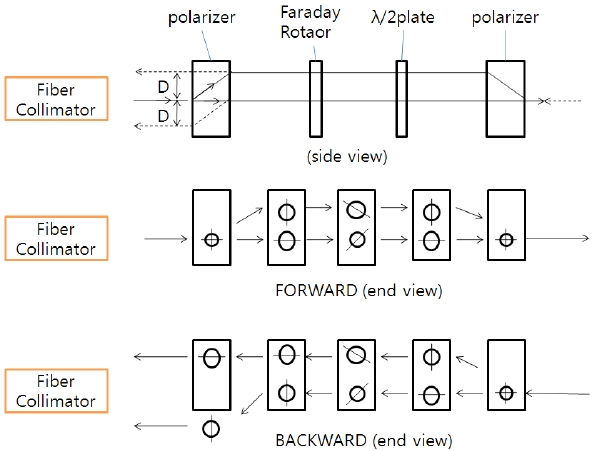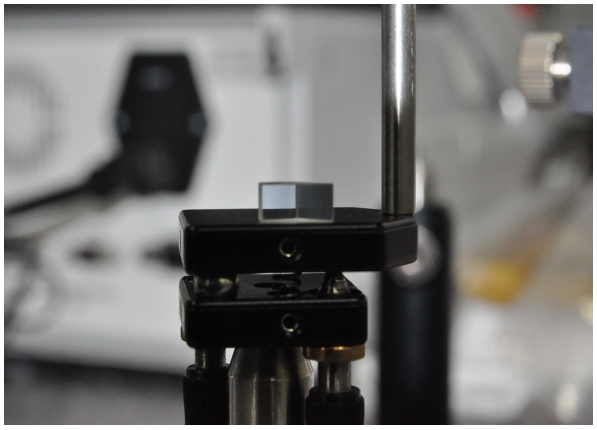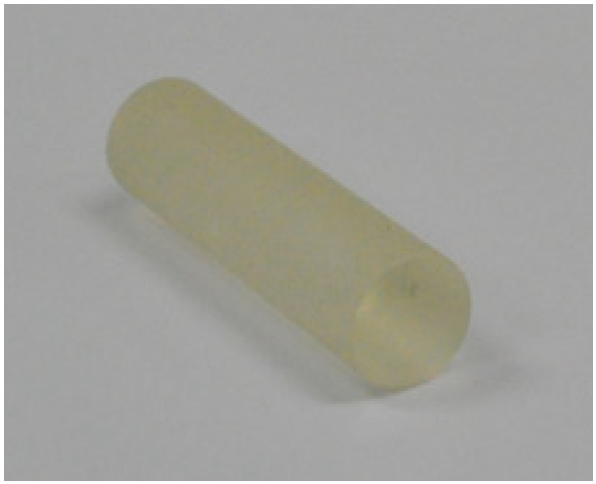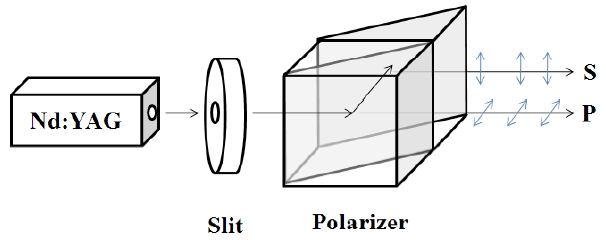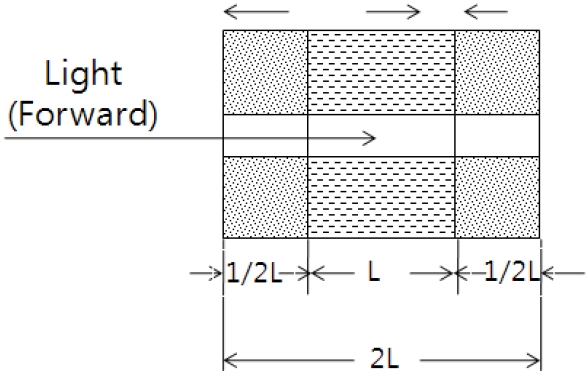



The structure of the laser produced using the optical fiber can be classified into the module and delivery components. The optical isolator is attached at the end of the delivery component of the laser.
The optical isolator permits only forward transmission of light, and prevents transmission in the backward direction. It is hence regarded an essential optical component in medical, industrial, and research lasers for blocking reflection beams that cause optical damage and noise. It is also used as a communicative light intensifier to expand the lifespan of devices and enhance transmission quality [1-3]. Optical isolators can be classified into two types: polarization-dependent and polarization-independent [4]. The former type functions as an isolator only when the transmitted light presents a consistent polarization direction, while the latter can function as an isolator regardless of the direction of the transmitted light. The polarization-dependent type is commonly used in a laser diode whereas the polarization-independent type is used in an optical fiber inten-sifier.
This study used the walk-off phenomenon [5,6] of extraordinary rays in birefractive materials to validate the characteristics of the Faraday rotator with the help of a walk-off polarizer and a magneto-optical (MO) glass to produce a polarization-independent isolator.
The polarizer plays an important role in determining the performance of the optical isolator as it permits transmission of substances parallel to the reflective side, whereas it reflects substances that are not parallel to the reflective side during transmission of the incident laser. On one hand, laser transmitted through the optical isolator is divided into two paths after passing through the first polarizer, and once the direction of the polarized light is rotated 90°, directly moving light passes by the Faraday rotator to be focused on the analyzer, that is, the second polarizer, for output. On the other hand, light moving in the reverse direction first passes the analyzer to be divided into an ordinary and an extraordinary ray. It does not affect the optical fiber that uses the light source. This is because a phase difference of 90° is formed with the direction of the polarized light during forward propagation of light as 45° rotations are made when moving by the Faraday rotator and MO material. The walk-off polarization principle of the optical isolator is shown in Fig. 1.
The MO glass used in the Faraday rotator in this study selected a walk-off distance of 4 mm in consideration of the 10-mm diameter and beam size of the fiber laser. The produced walk-off polarizer is presented in Fig. 2.
The produced walk-off polarizer was designed with a 1,000:1 extinction ratio to penetrate vertical polarization materials and reflect horizontal polarization materials. In addition, a polarization beam splitter (PBS) that can withstand a large output of up
to 10 W was used to maintain the 4-mm beam walk-off distance.The polarizer was designed and produced in sizes of 8 × 4 × 4 mm.
To rotate the polarized light by 45° using the nonreciprocal method, the Faraday rotator that is used to generate the phase difference in the light incident on the isolator needs an MO glass with a large proportional factor value and a permanent magnet for generating an appropriate magnetic field [7-10]. Various MO materials have been developed for the Faraday rotator including optical crystals, such as terbium gallium garnet (TGG) and yttrium iron garnet (YIG), rare earth-additive silica-optical glass,such as FR5 and MOG10, glycogen-optical glass, such as As-Se [11], and films such as (TbBi)3(FeAl)5O12. However, TGG and Tb-doped silicate glass are being used for large outputs of more than 10 W level. For the MO glass, this study used MR3-2, a lowcost terbium-doped borosilicate glass that has a high optical constant, low absorption coefficient, low nonlinear refractive index, and high damage threshold for laser energy. The MO glass used in this study is shown in Fig. 3.
Magnetic substances used in the generation of the magnetic field include the alnico magnet, ferrite magnet, samarium-cobalt magnet, and neodymium magnet. This study used the neodymium magnet, which is mainly composed of rare-earth elements, pure iron, and boron. This magnet has relatively stronger magnetism and can be processed more easily when compared with the samarium-cobalt magnet.
The walk-off polarizer was produced using PBS to penetrate the vertical polarization substances and reflect the horizontal polarization substances. The performance of the walk-off polarizer was evaluated by conducting an extinction ratio test on the polarizer using an Nd:YAG laser of 1,064 nm wavelength . A simple schematic diagram representing the extinction ratio test of the polarizer is shown in Fig. 4.
The extinction ratio test is an experiment for measuring the performance of the polarizer in distributing the vertical and horizontal substances of the laser. To accurately determine the laser polarization status, the experiment was designed such that a fil-
[Table 1.] Extinction ratios test result.

Extinction ratios test result.
[Table 2.] Degree of polarization versus wavelength.
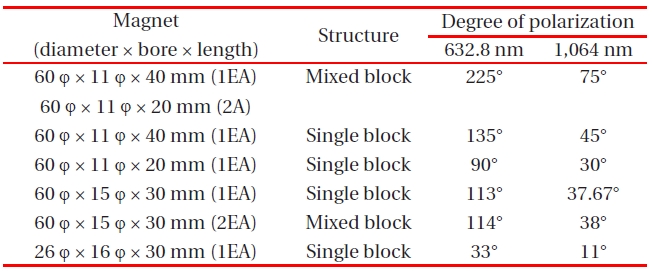
Degree of polarization versus wavelength.
ter was used to extract only the vertical polarization substances, and the polarization status was converted to measure the maximum point of reflected or penetrated light. A slit was used to transmit the measured light source into the laser power meter (LaserStar; Ophir Corporation, Littleton, CO, USA) to prevent reflected or penetrated light from affecting measurement during experiment. The output of the laser was measured between 0.03225 and 2.682 W. The results of the extinction ratio test using the walk-off polarizer are presented in Table .1 The extinction ratios of the ordinary and extraordinary rays generated using the walk-off polarizer were verified to be approximately 1,000:1.
3.2 Evaluation of the faraday rotator characteristics
The permanent magnet is an important component of the Faraday rotator that affects its performance and determines the size of the optical isolator. The performance and size of the Faraday rotator are in turn largely dependent on the strength and characteristics of the permanent magnet. The permanent magnet used in the Faraday rotator is composed either of a single-block structure using one permanent magnet or of a complex-block structure produced by integrating various pieces of single blocks. As the complex-block structure can considerably increase the magnetic field strength, it can be used as a miniature optical device and is thus being frequently developed for this use.
This study used an MO glass of diameter 10 φ and length 37 mm as the MO material of the Faraday rotator. Permanent magnets of 4 standards such as the following: (1) 60 φ external diameter × 11 φ internal diameter × 40 mm length, (2) 60 φ external diameter × 11 φ internal diameter × 20 mm length, (3) 60 φ external diameter × 15 φ internal diameter × 30-mm length (4) 26 φ external diameter × 16 φ internal diameter × 30 mm length were produced and a single or complex block was composed to install in the magnet holder. The degree of polarization was measured
[Table 3.] Loss measurement results.

Loss measurement results.
for two wavelengths: 632.8 and 1,064 nm.
In the initial condition without the Faraday rotator, the polarization status of the polarization analyzer (TXP 5004; Thorlabs Inc., Newton, NJ, USA) was set to 0°. The rotator was then fastened to the center of each magnetic substance and the degree of rotation was measured from 0°. As a result, changes in polarization angle could be verified according to the strength and wavelength of the magnetic field. In particular, a higher angle of polarization was observed in the complex-block magnetic structure. Thus, this study used a neodymium magnet of 60 φ external diameter, 11 φ internal diameter, and 40 mm length to make the Faraday rotator and applied this rotator to obtain a 45° polarization in the 1,064 nm wavelength Nd:YAG laser.
3.3 Measurement of penetration ratio
The penetration ratio was measured using the produced polarizer and Faraday rotator. An Nd:YAG laser was used for the experiment, and the input power was increased from 100 mW to 400 mW in units of 100 mW. The output was measured by passing the produced polarizer and Faraday rotor in the laser power meter. Results are presented in Table 3.
The power of the input laser beam was increased to increase the output obtained, and the results show that the average penetration rate was approximately 81.4%.
The optical isolator is used to enhance the protection and safety of devices and finds applications in the optical fiber laser and optical communication system. This study analyzed the characteristics of the core components of the isolator, namely, the walk-off polarizer and the Faraday rotator, to produce a polarization-independent isolator.
The walk-off polarizer used PBS to endure a large output of up to 10 W and was designed and produced to present a spectrum of horizontal and vertical rays in 1,000:1 ratio. Based on the measurement of the extinction ratios of the produced walk-off polarizer, the ratio of the vertical and horizontal rays was measured to be 1,050:1 with 0.032 W laser output and 1,010:1 with 2.68 W laser output , thus presenting ratios similar to 1,000:1.
Terbium-doped borosilicate glass (MR3-2) used for the MO substance of the Faraday rotator and various forms of permanent magnets produced in neodymium were used to analyze the characteristics of the Faraday rotor. The experiment applied 632.8 nm and 1,064 nm light in various forms of single or complex-block magnetic fields to measure the degree of polarization versus the wavelength. Finally, the Faraday rotator composed using the single-block neodymium magnet of 60 φ external diameter, 11 φ internal diameter and 40 mm length was used to obtain 45° polarization of the 1,064 nm wavelength light used in the isolator. The walk-off polarizer and Faraday rotator produced as a result of the study were used to compare the changes in output on the basis of changes in power of the input light and to check the penetration ratio. The experimental results showed variations in output value according to changes in power of input light. However, the average penetration ratio remained relatively consistent (~81.4%).
